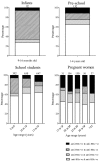Hepatitis B virus in the Lao People's Democratic Republic: a cross sectional serosurvey in different cohorts
- PMID: 25149478
- PMCID: PMC4158128
- DOI: 10.1186/1471-2334-14-457
Hepatitis B virus in the Lao People's Democratic Republic: a cross sectional serosurvey in different cohorts
Abstract
Background: Despite hepatitis B vaccination at birth and at 6, 10 and 14 weeks of age, hepatitis B virus (HBV) infection continues to be endemic in the Lao People's Democratic Republic (PDR). We carried out a cross-sectional serological study in infants, pre-school children, school pupils and pregnant women to determine their burden of disease, risk of infection and vaccination status.
Methods: A total of 2471 participants between 9 months and 46 years old were recruited from urban (Vientiane Capital, Luang Prabang), semi-urban (Boulhikhamxai and Savannakhet) and remote rural areas (Huaphan). All sera were tested for anti-HBs and anti-HBc. Sera testing positive for anti-HBc alone were further tested for the presence of HBsAg.
Results: A low prevalence of HBsAg (0.5%) was detected among infants from Vientiane and Luang Prabang, indicating some success of the vaccination policy. However, only 65.6% had protective anti-HBs antibodies, suggesting that vaccination coverage or responses remain sub-optimal, even in these urban populations.In pre-school children from remote areas in Huaphan, 21.2% were positive for anti-HBc antibodies, and 4.6% were for HBsAg positive, showing that a significant proportion of children in these rural regions have early exposure to HBV. In pre-school children with 3 documented HBV vaccinations, only 17.0% (15/55) were serologically protected.Among school-children from semi-urban regions of Luang Prabang, Boulhikhamxai and Savannakhet provinces, those below the age of 9 who were born after HBV vaccine introduction had anti-HBc and HBsAg prevalence of 11.7% and 4.1%, respectively. The prevalence increased to 19.4% and 7.8% of 10-14 year olds and to 27% and 10.2% of 15-19 year olds.Pregnant women from Luang Prabang and Vientiane had very high anti-HBc and HBsAg prevalence (49.5% and 8.2%), indicating high exposure and risk of onward vertical transmission to the unborn infant.
Conclusions: Overall, the results demonstrate a dramatic deficiency in vaccination coverage and vaccine responses and/or documentation within the regions of Lao PDR studied, which included urbanized areas with better health care access. Timely and effective hepatitis B vaccination coverage is needed in Lao PDR.
Figures
References
-
- WHO . Hepatitis B fact sheet. 2000.
-
- WHO . Western Pacific Regional Plan for Hepatitis B control through immunization. 2007.
-
- WHO Progress towards meeting the 2012 hepatitis B control milestone: WHO Western Pacific Region, 2011. Wkly Epidemiol Rec. 2011;86(19):180–188. - PubMed
Pre-publication history
-
- The pre-publication history for this paper can be accessed here:http://www.biomedcentral.com/1471-2334/14/457/prepub
MeSH terms
Substances
LinkOut - more resources
Full Text Sources
Other Literature Sources
Medical


